Eid-e-Milad holiday in Mumbai district rescheduled from 16 September 2024 to 18 September 2024.
Blog
Top Stories
Resignation can be withdrawn before it’s acceptance is communicated to the employee – Supreme Court
The Supreme Court held that Internal communication about accepting the employee’s resignation letter could not be said to be acceptance of the resignation letter. It added that unless such acceptance was communicated to the employee, the resignation could not be deemed to be accepted.
Copy of judgement attached.
Eid-e-Milad holiday in Mumbai district rescheduled from 16 September 2024 to 18 September 2024.
Eid-e-Milad holiday in Mumbai district rescheduled from 16 September 2024 to 18 September 2024.
The Government of Maharashtra has issued a notification dated 13.9.24 rescheduling the public holiday of Eid-e-Milad to Wednesday, September 18, 2024 instead of Monday, September 16, 2024.
Copy of notification attached.
Procurement Notice – State Pharmaceuticals Corporation of Sri Lanka
We wish to inform you that, the Chairman, Standing Cabinet Appointed Procurement Committee of the Ministry of Health has invited sealed bids for supply of following items to the Ministry of Health for year 2024.
| Bid Number | Closing Date & Time | Item Description | Non – refundable Bid Fee (LKR) |
| DHS/P/C/WW/05/23 | 07.10.2024
at 10.00 a.m. |
6,000 vials of Tenecteplase
Injection 40mg vial. |
100,000/-+ Tax |
Please find attached herewith a copy of the procurement notice of the above.
It would be appreciated, if you could kindly make necessary arrangements to disseminate the same among your membership.
Thank you.
With warm regards,
Shirani Ariyarathne
Actg. Consul General
Minister (Commercial)
Consulate General of Sri Lanka
34, Homi Mody Street, Fort
Mumbai 400001
Tel: (+ 91 22 )22045861/22048303
Fax: (+ 91 22) 22876132
E -mail: slcg.mumbai@mfa.gov.lk
It would be appreciated, if you could kindly make necessary arrangements to disseminate the same among your membership.
Invitation for Bids (IFB) – Ceylon Petroleum Storage Terminals Limited.
Invitation for Bids (IFB) – Ceylon Petroleum Storage Terminals Limited.
Contract No. KPR/60/2024 – Repairs to Petrol Loading Tanks No. TK-31 and TK-32 at Muthurajawela Terminal
We wish to inform you that, the Chairman, Ministry Procurement Committee (MPC), on behalf of the Ceylon Petroleum Storage Terminals Limited has invited sealed bids from eligible and qualified bidders for Repairs to Petrol Loading Tanks No. TK-31 and TK-32 at Muthurajawela Terminal. The total construction period is 300 calendar days.
Closing date for the submission of above IFB is on or before 1400 hrs (Sri Lanka local time GMT+5:30) on 11th October 2024.
Please find attached herewith a copy of the procurement notice of the above.
It would be appreciated, if you could kindly make necessary arrangements to disseminate the same among your membership.
Thank you.
With warm regards,
Shirani Ariyarathne
Actg. Consul General
Minister (Commercial)
Consulate General of Sri Lanka
34, Homi Mody Street, Fort
Mumbai 400001
Tel: (+ 91 22 )22045861/22048303
Fax: (+ 91 22) 22876132
E -mail: slcg.mumbai@mfa.gov.lk
Invitation for Bids – Ministry of Defence
Invitation for Bids – Ministry of Defence.
Commercial Explosives, Firearms and Ammunition Procurement Unit (CEFAP) Welisara, Ragama
We wish to inform you that, the Chairman, Department Procurement Committee of Sri Lanka Navy on behalf of Commercial Explosives, Firearms and Ammunition Procurement Unit (CEFAP) has invited sealed bids from eligible and qualified bidders for following Electric Detonators.
| File No | Description | Quantity |
| CEFAP/PRT/05/2022 | Red Phospurus | 6,000 Kgs |
| CEFAP/PRT/08/2022 (SD)
|
Electric Detonators (4 MTR) | 1,000,000 Nos |
Closing date for the submission of above bid is on 24th September 2024 at 1400 hrs (Sri Lanka local time GMT+5:30).
Please find attached herewith a copy of the paper advertisement of the above.
Thank you.
With warm regards,
Shirani Ariyarathne
Actg. Consul General
Minister (Commercial)
Consulate General of Sri Lanka
34, Homi Mody Street, Fort
Mumbai 400001
Tel: (+ 91 22 )22045861/22048303
Fax: (+ 91 22) 22876132
E -mail: slcg.mumbai@mfa.gov.lk
It would be appreciated, if you could kindly make necessary arrangements to disseminate the same among your membership.
MSME Conclave 2024 Focuses on Funding the Backbones of India’s Economy
MSME Conclave 2024 Focuses on Funding the Backbones of India’s Economy
Mumbai – Micro, Small, and Medium Enterprises (MSMEs) are the backbone of India’s economy, comprising over 6 crore enterprises that contribute significantly to employment, innovation, and economic diversification. Despite their importance, MSMEs often face significant challenges in accessing adequate and timely finance, hindering their growth potential. The Bombay Chamber of Commerce & Industry hosted the 2024 MSME Conclave, focusing on the crucial theme of “Financing SME Growth.”
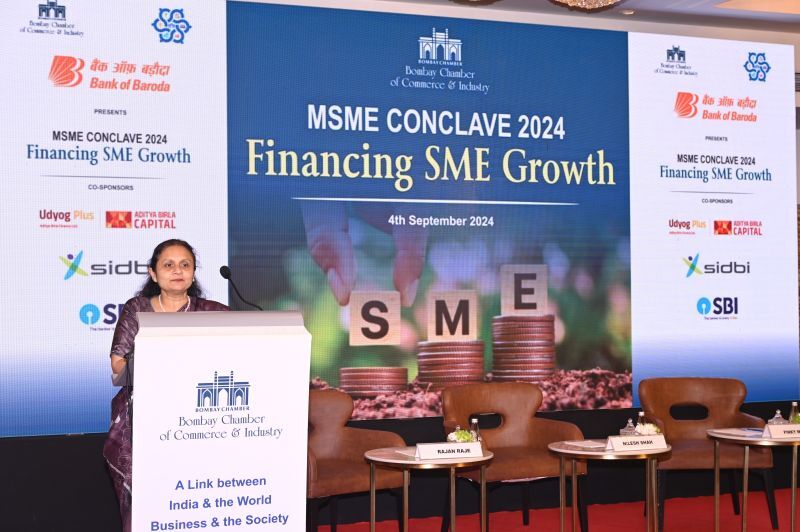
In her welcome address, Pinky Mehta, President of the Bombay Chamber, and Director, Aditya Birla Sun Life Insurance Ltd, highlighted the Chamber’s 188-year legacy in India’s development and its extensive representation of MSMEs. She underscored the Chamber’s commitment to supporting MSMEs in overcoming financial challenges and unlocking their growth potential.
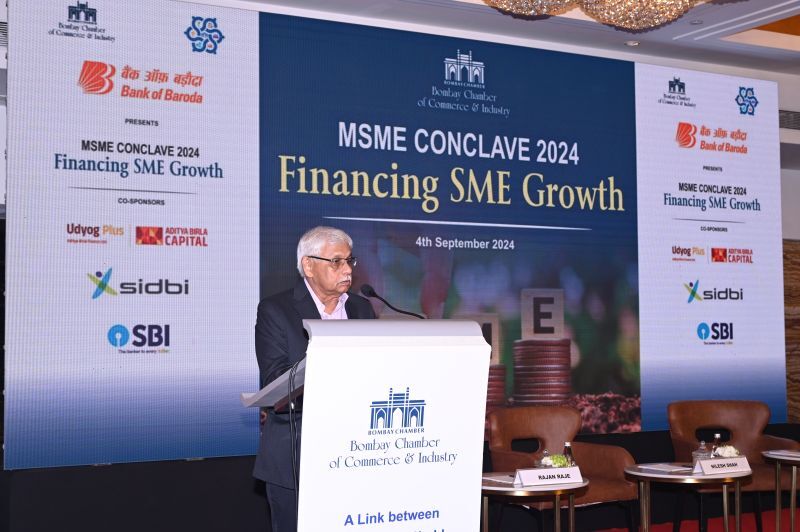
Rajan Raje, Chairperson of the MSME Committee, Bombay Chamber and CEO of Nichem Solutions, set the theme for the Conclave. He emphasised that while the MSME sector is the largest employment generator, it often lacks professionalism and resources. He acknowledged the government’s initiatives, such as the New Credit Guarantee Scheme, increased Mudra Loan limits, and the expansion of the TReDS platform, which support the sector’s growth. “The SME sector must think big and explore the export market systematically,” Raje stated, adding that credit availability is largely determined by the “3 C’s” – Cash Flow, Character, and Collateral.
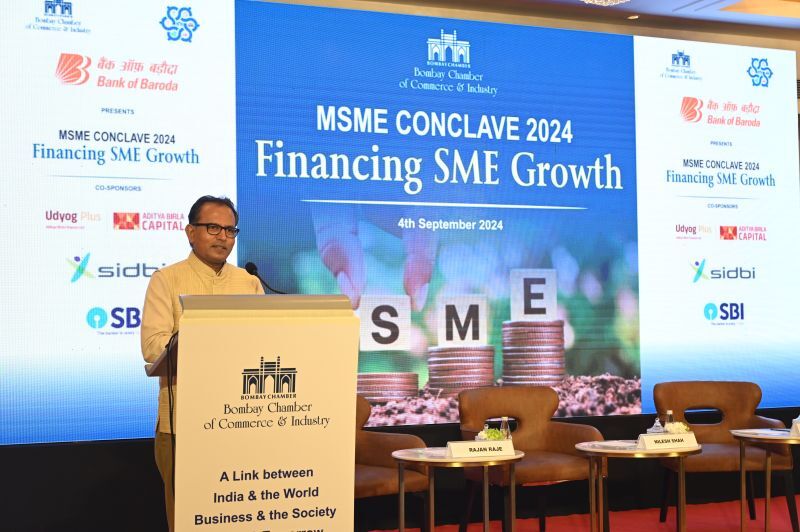
The keynote address was delivered by Nilesh Shah, Group President & MD of Kotak Mahindra AMC, who discussed the challenges and opportunities faced by MSMEs. He spoke about the need for resources in the form of equity, debt, and hybrid financing to enable faster growth. Shah highlighted three successful models that MSMEs could emulate: The Morbi Model: Post-flood rebuilding of Morbi into a ceramics hub, now accounting for 90% of India’s ceramics production with $2 billion in exports. The Tirupur Model: Textile manufacturers form a cooperative for efficient cost management and industry-scale benefits, including centralised purchasing, advertising, and pollution management and the Amul Model: The cooperative that transformed India into the world’s largest milk producer and aims to be the largest FMCG company by 2047. Shah also lauded the Reserve Bank of India’s new system for instant verification of SMEs and borrowers, which will significantly shorten the credit appraisal cycle.
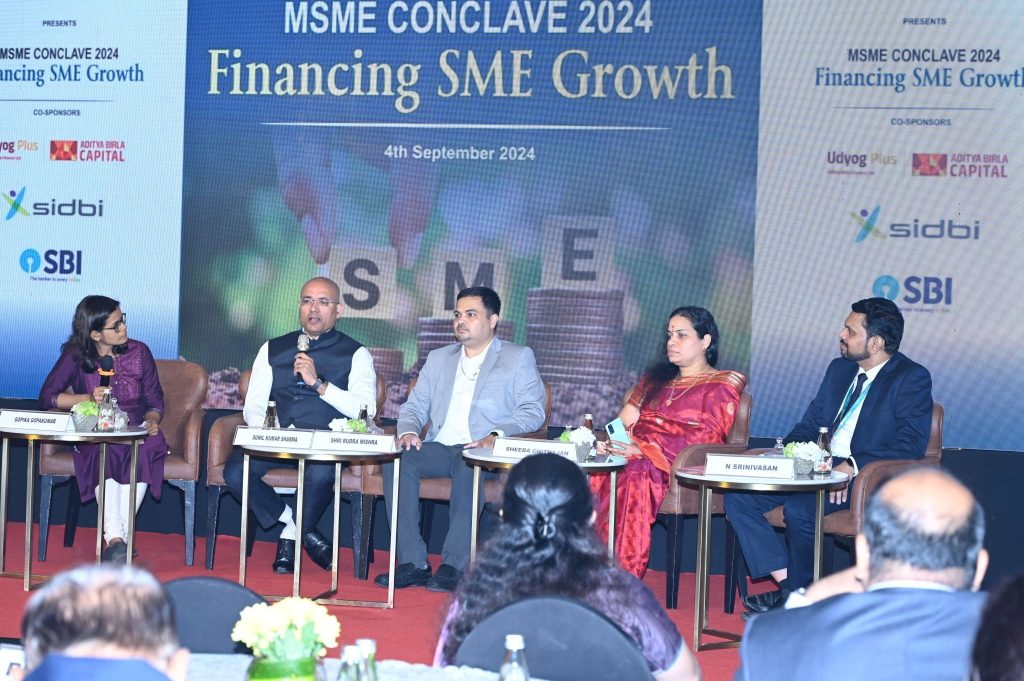
The Conclave featured two insightful panel discussions. The first panel on “Export-Import Financing” for SMEs, moderated by Gopika Gopakumar, Senior Assistant Editor, Livemint, Mr. Sunil Kumar Sharma, General Manager & Zonal Head, Bank of Baroda, Shri Rudra Mishra, Assistant General Manager, SIDBI, N Srinivasan, General Manager Transaction Banking, IDBI Bank and Sheeba Chithajan, DGM (SME) SBI LHO Mumbai Metro. They discussed how their institutions are supporting SMEs in entering and thriving in the export market, including the range of financial products available for the MSME sector. They highlighted the hygiene factors that banks expect SMEs to meet before receiving export support. The panel also examined the challenges MSMEs face in accessing funding, especially for exports to developing countries, and shared success stories and their impacts on SME growth.
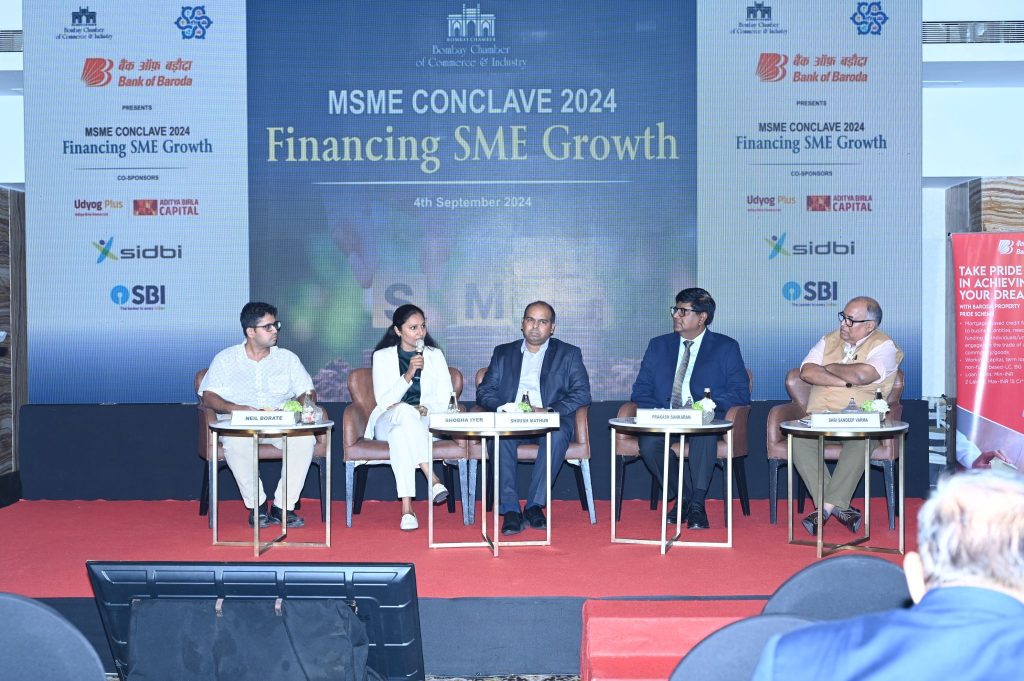
The second panel, titled “Financing Through NBFCs,” was moderated by Neil Borate, Deputy Editor at Livemint, and featured Shobha Iyer, Director Commercial at Olea; Shirish Mathur, Head of SME Products & Digital Platforms at Aditya Birla Finance Ltd.; Prakash Sankaran, Managing Director & CEO of Invoicemart; and Sandeep Varma, CEO of the Credit Guarantee Fund Trust for Micro and Small Enterprises (CGTMSE). The discussion highlighted the crucial role of Non-Banking Financial Companies (NBFCs) in supporting SMEs through tailored financial products, flexible loan terms, and faster processing times compared to traditional banks. The panellists also explored potential solutions, including government subsidies, credit guarantees, and fostering a competitive lending environment to help reduce interest rates.
In a fireside chat titled “Catalysing SME Growth Through Innovative Financing Solutions,” Shri Deependra Singh Kushwah, I.A.S., Development Commissioner (Industries), Government of Maharashtra, discussed government initiatives to support MSMEs, including the MAITRI portal and the MIDC Plug and Play facility. He also requested members of the MSME sector to leverage these tools and initiatives and proactively approach the Government for any support or guidance.
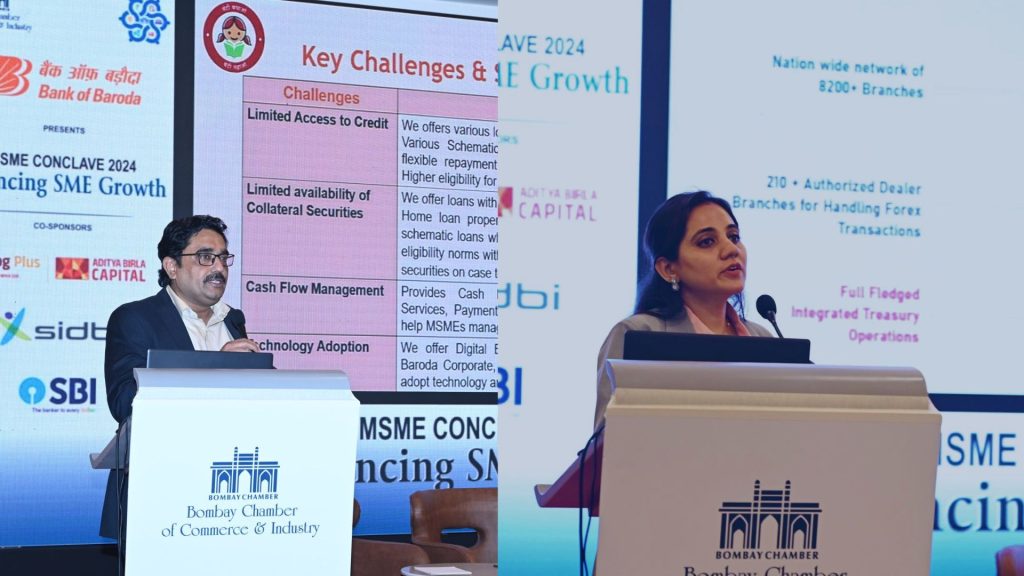
The Conclave also featured a presentation by the Bank of Baroda on “Empowering MSME Growth: Leveraging Our Flagship Products & Trade Finance Offerings,” delivered by Sandeep Prakash, Assistant General Manager of MSME Sales, and Tania Das, Senior Manager of the Forex Department, Mumbai Zone. Additionally, Shirish Mathur presented the facilities and services available to MSMEs on the Aditya Birla Udyog Plus website.
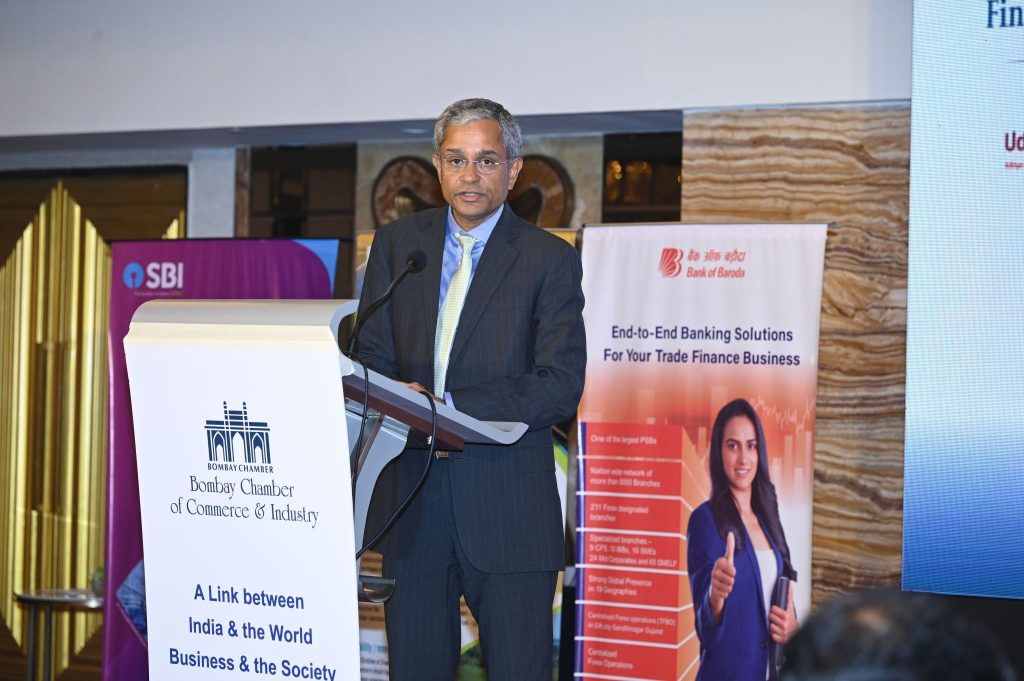
Rajiv Anand, Senior Vice President of the Bombay Chamber and Deputy Managing Director of Axis Bank, delivered the Vote of Thanks . The event was supported by Bank of Baroda, Aditya Birla Finance Ltd., SIDBI, and SBI.
Bombay Chamber CSR Conclave focuses on leveraging Technology for Social Good
Bombay Chamber CSR Conclave focuses on leveraging Technology for Social Good
With the new CSR mandate, companies in India must look to integrate digitalisation into their CSR journeys. Keeping this in context, Bombay Chamber of Commerce & Industry organised its annual CSR Conclave in Mumbai yesterday. The theme of the Conclave was CSR in the Digital Era.
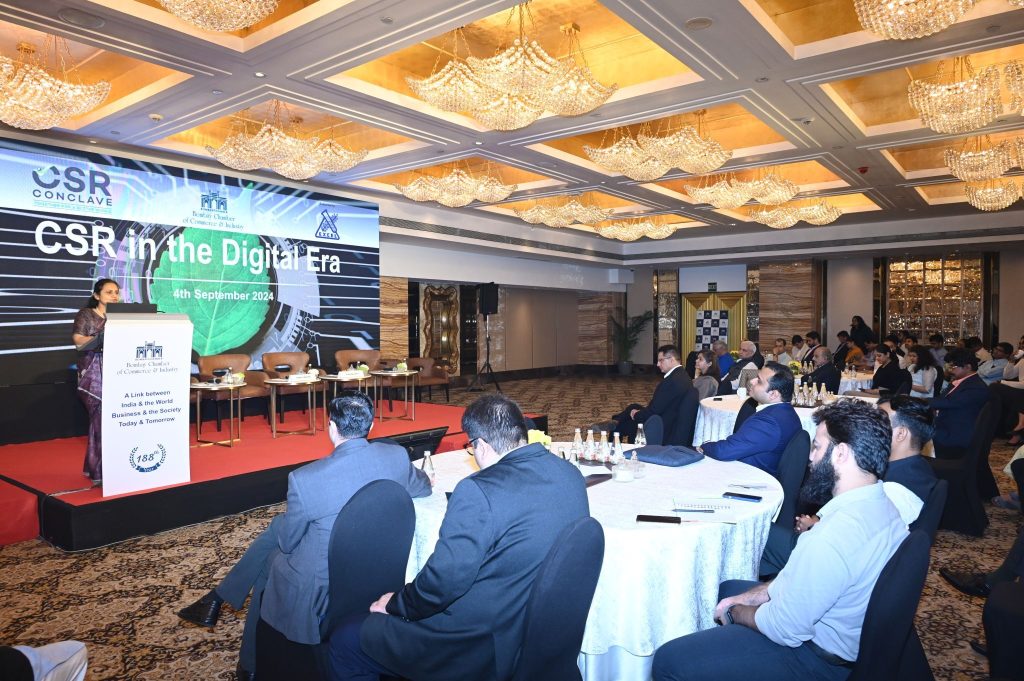
In her opening remarks, Pinky Mehta, President, Bombay Chamber & Chief Financial Officer, Aditya Birla Capital said, “In today’s world, with technology and digital platforms revolutionising the way we live, work, and connect, CSR strategies need to embrace technology for driving meaningful impact.
With AI and Blockchain, ChatGPT and Data Analytics, digitalisation emerges as a potent instrument for organisations to magnify their CSR endeavours, engage stakeholders, and foster a culture of transparency and good governance. Leveraging technology for Social Good is not just a choice anymore, it is an
imperative.”
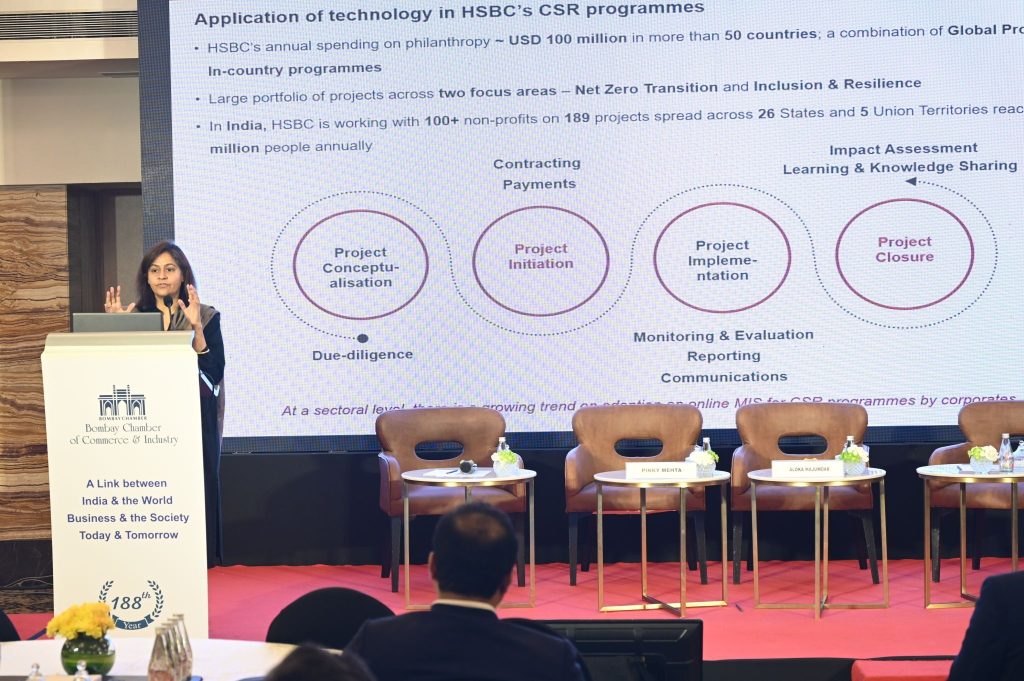
This was followed by a presentation by Aloka Majumdar, Chairperson, CSR Committee, Bombay Chamber and Managing Director, Global Head of Philanthropy & Head of Sustainability, India, HSBC. She shared the practical application of CSR integration into a business, and how she effectively facilitates collaboration and knowledge sharing on this very important area in her organisation.
She pointed out that there is increasing expenditure on CSR – as per the latest Economic Survey, CSR spending has increased from ₹17,096 crore in FY 2017-18 to ₹26,278 crore in FY 2021-22. “There is a growing need for enhanced governance for CSR across the grant cycle; increasing compliance (internal and external); greater focus on measuring outcomes, impact assessment, reporting and communication including disclosures; process improvements and building institutional memory,” she stated.
She elaborated on the need for technology in CSR. “We need to bring in technology and governance to increase compliance, BSR, ESG and other reporting. Raise funds for non-profit organisations and capture the right data,” she added.
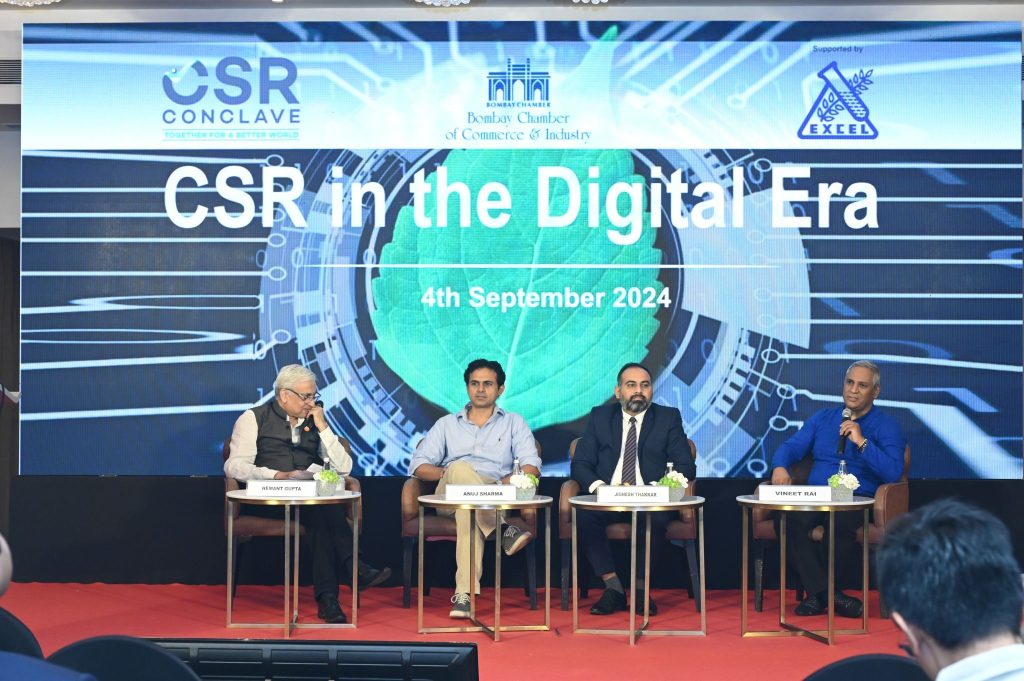
The first panel discussion on Technology and Social Entrepreneurship Funding was moderated by Hemant Gupta, MD & CEO, EQUIPPP Desi Investments. The panelists included Anuj Sharma, Founder Director, Alsisar Impact; Jignesh Thakkar, Partner & COO, ESG Advisory & Head, Social & CSR Consulting, KPMG India and Vineet Rai, Founder and Chairman, Aavishkaar Group.
The discussion observed that Technology assists us in multiple sectors, hence it is both an enabler and a solution and service to all. In the role that technology should play in social development, localising the solution is very important.
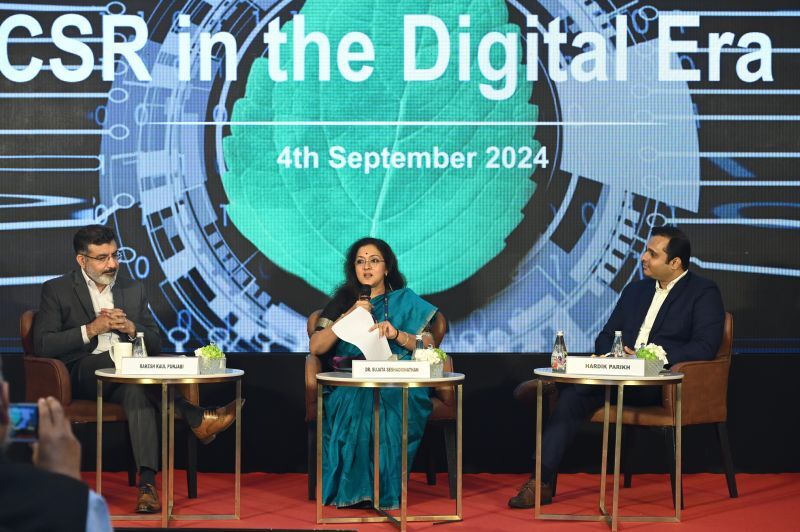
A Fireside Chat on AI for Social Good saw Rakesh Kaul Punjabi, Technology Consulting Partner, EY India and Dr. Sujata Seshadrinathan, Director – IT, Basiz Fund Services, Mumbai in discussion with Hardik Parikh, Senior Consultant, Sattva.
The discussion revolved around three main aspects – the potential of AI for social good, the Indian AI landscape and how to bolster AI and the CSR system.
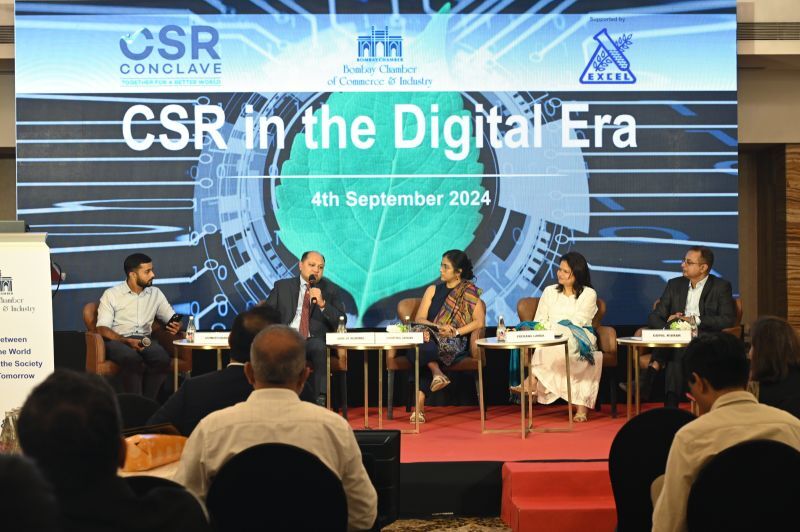
The second panel discussion focused on Leveraging Digital Platforms to drive CSR. The session was moderated by Ashwath Bharath, Senior Director, Teach For India and the panelists included Abhejit Agarwal, Head – Sustainability & CSR, Axis Bank; Shrutika Jadhav, Head- Catalytic Philanthropy, Dasra; Gopal Kumar, Head, CSR, Aditya Birla Capital and Prerana Langa, CEO, Aga Khan Agency, Habitat India.
The discussion revolved around using technology to reach out to the community effectively and transparently. The panel also called upon the need to invest in non profit building systems that reduce the time spent on compliance issues and reusing data ethically to be able to make decisions at a meta level.
The event was supported by Excel Industries.
Invitation for Bids (IFB) – Ceylon Petroleum Storage Terminals Limited.
Invitation for Bids (IFB) – Ceylon Petroleum Storage Terminals Limited Contract No. KPR/58/2024 – Consultancies Services for Developing and Implementing a Comprehensive Oil Balance Work of Proposed 6 Nos. Storage tanks at Kolonnawa Installation – Stage 2.
We wish to inform you that, the Chairman, Standing Cabinet Appointed Procurement Committee (SCAPC), on behalf of the Ceylon Petroleum Storage Terminals Limited has invited sealed bids from eligible and qualified bidders for Balance Work of Proposed 6 Nos. Storage Tanks at Kolonnawa Installation – Stage 2.
Closing date for the submission of above IFB is on or before 1400 hrs (Sri Lanka local time GMT+5:30) on 27th September 2024.
Please find attached herewith a copy of the procurement notice of the above.
It would be appreciated, if you could kindly make necessary arrangements to disseminate the same among your membership.
Thank you.
With warm regards,
Shirani Ariyarathne
Actg. Consul General
Minister (Commercial)
Consulate General of Sri Lanka
34, Homi Mody Street, Fort
Mumbai 400001.
Tel: (+ 91 22 )22045861/22048303
Fax: (+ 91 22) 22876132
E -mail: slcg.mumbai@mfa.gov.lk
Procurement Notice – State Pharmaceuticals Corporation of Sri Lanka
Procurement Notices – State Pharmaceuticals Corporation of Sri Lanka
We wish to inform you that, the Chairman, Standing Cabinet Appointed Procurement Committee of the Ministry of Health has invited sealed bids for supply of following items to the Ministry of Health.
| Bid Number | Closing Date & Time | Item Description | Non – refundable Bid Fee |
| DHS/L/WW/24/25 | 19.09.2024
At 09.00 am |
Elisa kits for Hepatitis B | 20,000/- + Tax |
| DHS/L/WW/25/25
|
19.09.2024
At 09.00 am |
Cholesterol meters LCD display, Strips for cholesterol meters | 35,000/- + Tax |
| DHS/L/WW/26/25 | 19.09.2024
At 09.00 am |
Cupric Sulphate, Di sodium hydrogen phosphate | 12,500/- + Tax |
| DHS/L/WW/27/25 |
19.09.2024 At 09.00 am |
Culture Media | 3,000/- + Tax |
| DHS/L/WW/28/25 | 19.09.2024
At 09.00 am |
HLA Consumables for NBTS | 3,000/- + Tax |
| DHS/L/WW/29/25 |
19.09.2024 At 09.00 am |
Culture Media | 20,000/- + Tax |
| DHS/L/WW/30/25
|
19.09.2024
At 09.00 am |
Luminex Machine Specific reagents and consumables for NBTS | 3,000/- + Tax |
| DHS/L/WW/31/25 | 19.09.2024
At 09.00 am |
Laboratory consumables | 3,000/- + Tax |
| DHS/L/WW/32/25 | 19.09.2024
At 09.00 am |
Blood Grouping reagents | 35,000/- + Tax |
| DHS/L/WW/33/25 | 19.09.2024
At 09.00 am |
Eci Reagents | 35,000/- + Tax |
| BDHS/L/WW/34/25 | 19.09.2024
At 09.00 am |
Ethanol Absolute AR | 35,000/- + Tax |
| DHS/L/WW/35/25 | 19.09.2024
At 09.00 am |
Ethanol (96%) AR | 12,500/- + Tax |
| DHS/L/WW/98/24 | 19.09.2024
At 09.00 am |
Alfa test kit, Octra Test kit & Mycotoxin Test kit | 3,000/- + Tax |
| DHS/SS/WW/39/25 | 18.09.2024
At 09.00 am |
Leukocyte filters, TPE kits, stem cell harvest kit | 60,000/- + Tax |
| DHS/SS/WW/40/25 | 18.09.2024
At 09.00 am |
Proximal Femoral Nail anti rotation system | 60,000/- + Tax |
| DHS/SA/WW/19/23 | 20.09.2024
At 09.00 am |
Dermatology Consumable Items | 3,000/- + Tax |
| DHS/SA/WW/48/25 | 20.09.2024
At 09.00 am |
Orthopaedic Instrument sets and Component Items | 12,500/- + Tax |
| DHS/SA/WW/49/25 | 20.09.2024
At 09.00 am |
DCS Triple Reamer for dynamic condylar screw system | 3,000/- + Tax |
| DHS/SA/WW/50/25 |
20.09.2024 At 09.00 am |
Capsular Tension Ring | 3,000/- + Tax |
| DHS/SA/WW/51/25 |
20.09.2024 At 09.00 am |
Anaesthetic Consumable Items | 12,500/- + Tax |
| DHS/SA/WW/52/25 |
20.09.2024 At 09.00 am |
Keratome Knife | 35,000/- + Tax |
| DHS/SA/WW/53/25 |
20.09.2024 At 09.00 am |
Paracentesis knife | 20,000/- + Tax |
| DHS/SA/WW/101/24 |
20.09.2024 At 09.00 am |
Surgical Suture | 3,000/- + Tax |
| DHS/SA/WW/103/22 |
20.09.2024 At 09.00 am |
Cerebral Catheter | 3,000/- + Tax |
| DHS/SA/WW/104/22 |
20.09.2024 At 09.00 am |
Inferior Vena Cava Filter, introducer set | 3,000/- + Tax |
| DHS/SA/WW/105/22 |
20.09.2024 At 09.00 am |
Polypropylene suture, Monofilament | 3,000/- + Tax |
| DHS/SA/WW/106/22 |
20.09.2024 At 09.00 am |
Ophthalmic Consumable Items | 3,000/- + Tax |
Please find attached herewith a copy of the procurement notice of the above.
Thank you.
With warm regards,
Shirani Ariyarathne
Actg. Consul General
Minister (Commercial)
Consulate General of Sri Lanka
34, Homi Mody Street, Fort
Mumbai 400001
Tel: (+ 91 22 )22045861/22048303
Fax: (+ 91 22) 22876132
E -mail: slcg.mumbai@mfa.gov.lk
It would be appreciated, if you could kindly make necessary arrangements to disseminate the same among your membership.
Procurement Notice – SriLankan Airlines Ltd Ref. Nos. – 202430462 and 202332004
Procurement Notice – SriLankan Airlines Ltd Ref. Nos. – 202430462 and 202332004
I wish to inform you that, the Ministry Procurement Committee, Ministry of Ports, Shipping and Aviation on behalf of SriLankan Airlines Limited has invited sealed bids for supply of following items.
| Ref. No. | Item Description | Closing Date & Time |
| 202430462 | Invitation for submission of Bids for the Supply of Fruit Juices for on-board service | 24th September 2024 at 10:00 hrs (Sri Lanka local time GMT+5:30) |
| 202332004 | Invitation for submission of Bids for the Supply |
Please find attached herewith a copy of the procurement notice of the above.
It would be appreciated, if you could kindly make necessary arrangements to disseminate the same among your membership.


It is a long established fact that a reader will be distracted by the readable content of a page when lookin







